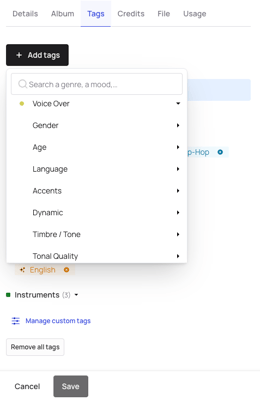This article explains how to use Bridge to efficiently manage voice-over projects: create a dedicated workspace, disable automatic music tagging, use the voice thesaurus to describe files, and showcase your artists.
Bridge.audio can also be used effectively to manage voice-over projects. Here are some best practices to make the most of the platform in this context.
1. Create a dedicated workspace
For voice-over projects, it is recommended to create a separate workspace. This helps keep your content organized and makes navigation easier for your team and clients. A dedicated workspace also simplifies tracking audio files and prevents any confusion with your music projects.
2. Disable automatic music tagging
In your workspace settings, make sure to disable automatic music tagging. While this feature is very useful for music, it can create unnecessary or confusing tags for voice-over files, which don’t require this type of analysis.

3. Use the voice thesaurus to describe your files
Bridge offers a voice thesaurus to accurately classify each recording. Use it to annotate your files with detailed descriptions (timbre, style, emotion, vocal type…). This makes searching and comparing files much faster and more efficient.

4. Showcase your artists with album names and covers
To make your workspace more visual and engaging, you can use album names and covers to represent each artist. This allows you to share their image and provide more context for your voice-over files—a practice already adopted by some Bridge users, as shown in this example.
